Brief History
- Elizabethan Drama is a general term used to refer to plays that took place during the reign of Queen Elizabeth the 1st.
- Elizabethan Drama took place between 1558 and 1603 (Barton & McGregor, 2011).
- During this era, drama majored on civil wars and successions.
- Elizabethan Drama was divided into three eras, namely: Elizabethan Theater-1562 to 1625,Jacobean Theater-1603 to 1625 and Caroline Theater-1625 to 1652 (Barton & McGregor, 2011).
Between the late 16th and early 17th centuries, the English drama flourished in London. Also known as the English Renaissance drama, the Elizabethan drama grew between1562 and 1652. Within this period, renowned writer and performer, William Shakespeare had begun his legendary works. The drama within this era was mainly based on civil wars as well as Kingdom succession. The Elizabethan drama era was characterized by three phases which were named after monarchs of the time (Barton & McGregor, 2011). They included: Elizabethan Theater which took place between 1562 and 1603, the Jacobean Theater that took place between 1603 and 1652; and the Caroline Theater extends that took place between 1625 and 1642. The Elizabethan drama ended in 1652 after the plays were banned by the Puritanical parliament.
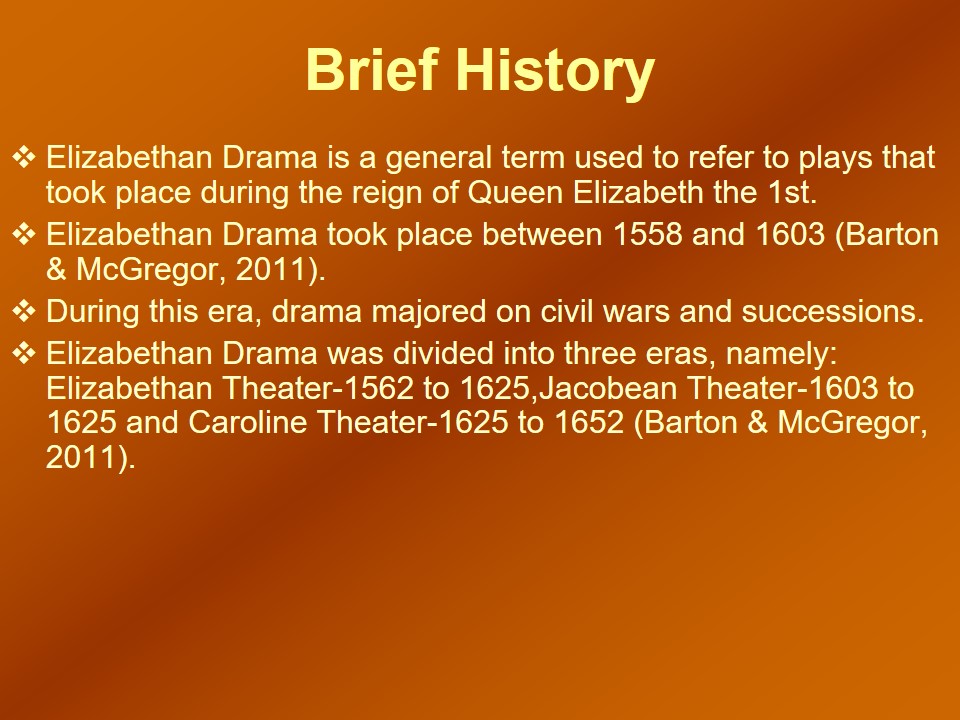
Venues of the Elizabethan Drama
- Elizabethan drama of the early times was performed in temporary theaters.
- Red Lion was the first permanent theater.
- Red Lion was opened in 1567 (Barton & McGregor, 2011).
- Theatre in Shoreditch was established in 1576 after the failure of the Red Lion.
- Permanent theaters were located outside the cities.
- They did not have rooftops.
The early Elizabethan dramas were not performed in permanent theaters. In most cases, traveling troupes performed these plays in the courtyards. The Red Lion was the first permanent theater that was opened in the year 1567 (Barton & McGregor, 2011). Due to its remote location, the Red Lion was not successful in yielding result. Since Theatre in Shoreditch was established at an ideal location, it became successful. The newly established theater hosted a more permanent basis for actors. Mainly because of the government regulations at that time, these permanent theaters were located outside the cities. Among other permanent theaters that followed included; The Globe, The swan, The Red Bull, The Rose and The Fortune. These permanent structures had an open space at the center and an extended stage which had three sides open for the audience. They did not have roofs. The permanent theaters offered most of London’s population the opportunity to see these plays.
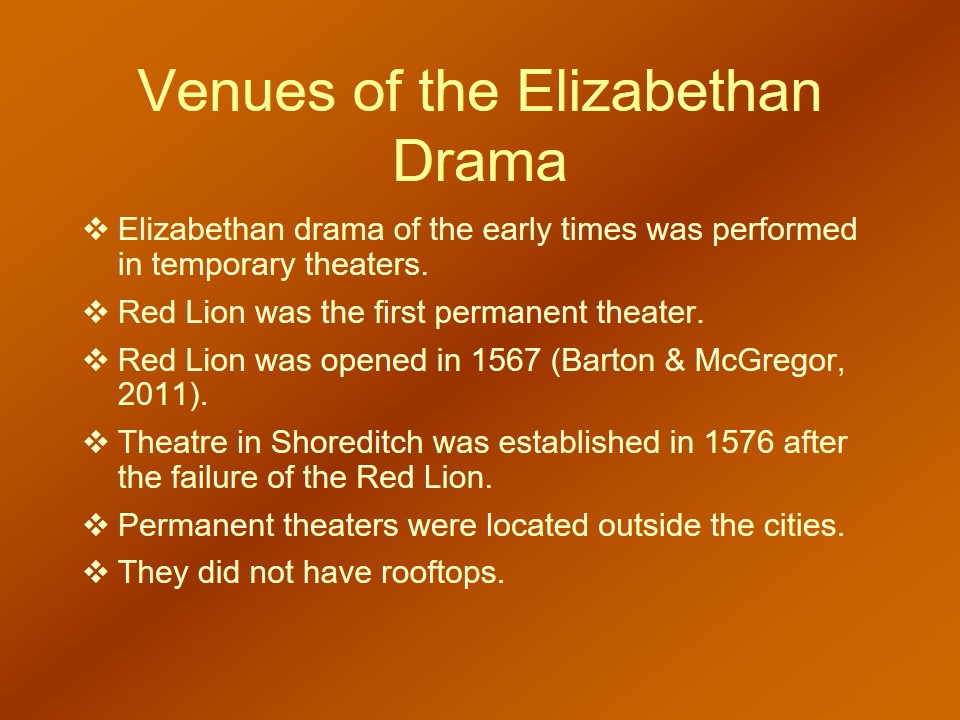
Genres of the Elizabethan Drama
- There were three main genres: comedy, tragedy and History.
- Comedies includes Shakespeare’s “A Midsummer Night’s Dream” and “Much about nothing” and Ben Jonson’s “Every Man in his Humor” (Barton & McGregor, 2011).
- Tragedy drama included Christopher Marlowe’s “Dr. Faustus,” and Shakespeare’s “Hamlet”.
- Historical drama focused on European and English history. They include William Shakespeare’s “Richard III” and Christopher Marlowe’s “Edward II”.
The Elizabethan drama was characterized by three main genres. These genres included history, tragedy and comedy. These genres can inappropriately be categorized as everybody knows how the play ends, everyone in the play dies and everybody gets married at the end, respectively. As far as these genres are concerned, in tragedies, misfortunes took place because of characters choices and flaws. Examples of the tragedy dramas include Christopher Marlowe’s “Dr. Faustus,” and Shakespeare’s “Hamlet” (Barton & McGregor, 2011). The historical dramas focused on European and English history. They include William Shakespeare’s “Richard III” and Christopher Marlowe’s “Edward II”. Another historical play recorded during the Elizabethan drama is the life of Julius Caesar that inspired Shakespeare works. Shakespeare was well known in comedies. His well-known plays are “A Midsummer Night’s Dream” and “Much about nothing”. Other comedies include Ben Jonson’s “Every Man in his Humor”.
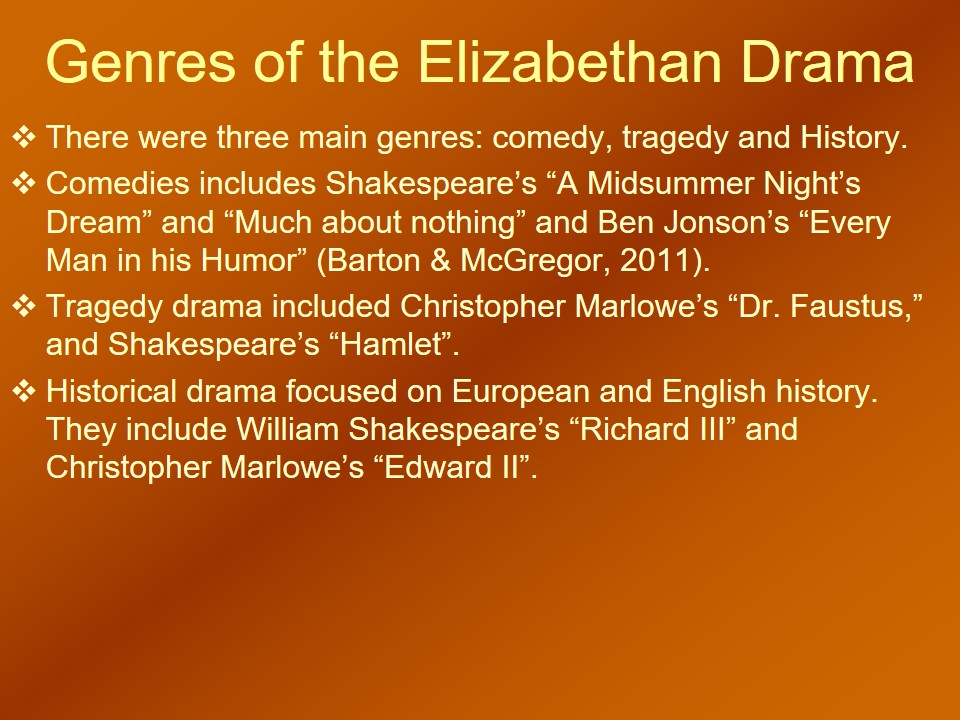
Famous Playwrights
- Shakespeare is the most renowned playwright of the Elizabethan drama era.
- Other famous playwrights include Thomas Heywood, Thomas Kyd, John Webster, Ben Jonson, Christopher Marlowe and Thomas Middleton (Barton & McGregor, 2011).
- During this period, writing was for entertainment.
- Works were not published or publicized.
- Theater rights belonged to the company.
World’s renowned playwright of all times, William Shakespeare is considered to be the master of playwrights of the Elizabethan drama era. On the other hand, there are other significant play writers who made an impact during this period. Known as Shakespeare’s contemporary, these play writers include Thomas Heywood, Thomas Kyd, John Webster, Ben Jonson, Christopher Marlowe and Thomas Middleton (Barton & McGregor, 2011). During Elizabethan era, writing was for entertainment . For that reason, works were not published or publicized. The theater rights belonged to the company which paid the playwright.
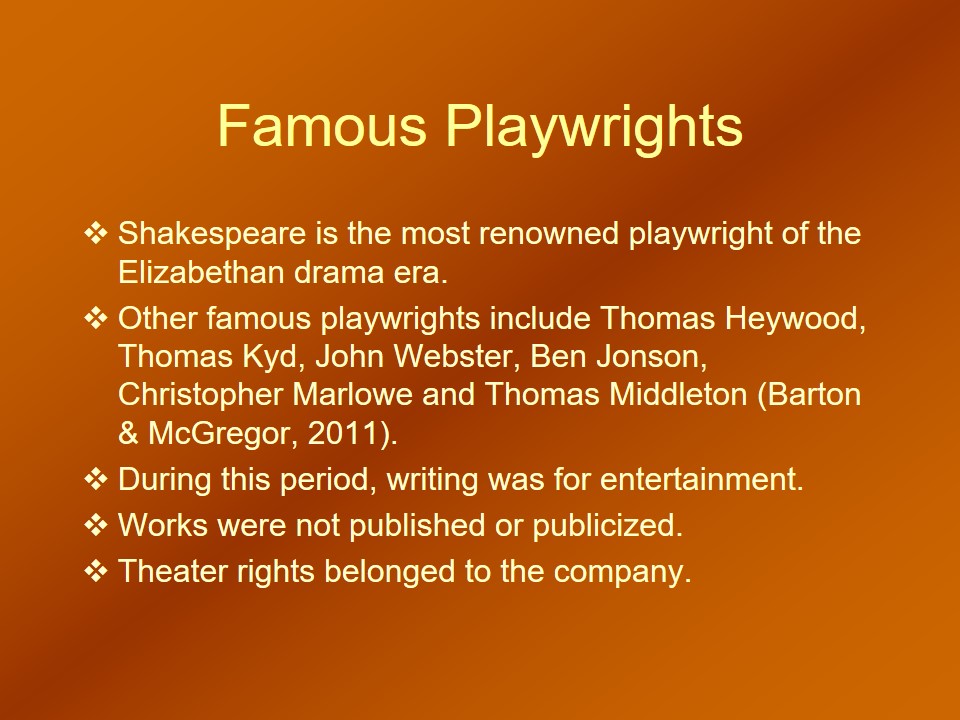
Staging of Shows
- All shows were characterized by a troupe of performers(Barton & McGregor, 2011).
- Women’s roles were played by men.
- Men who were given women’s roles looked like maidens.
- In Romeo and Juliet, Viola masquerades, a boy, perfectly plays the role of a woman.
Staging of the Elizabethan drama was more different than the contemporary stage. All shows were characterized by a troupe of performers who performed varied shows every night (Barton & McGregor, 2011). These shows were rarely the same twice in one week. Even though they were made in a beautiful manner, they were not specific to the shows. Women’s roles were played by men. Mostly these men were men who look like the female maidens. For example, in Romeo and Juliet, as a boy, Viola masquerades, perfectly plays the role of a woman.
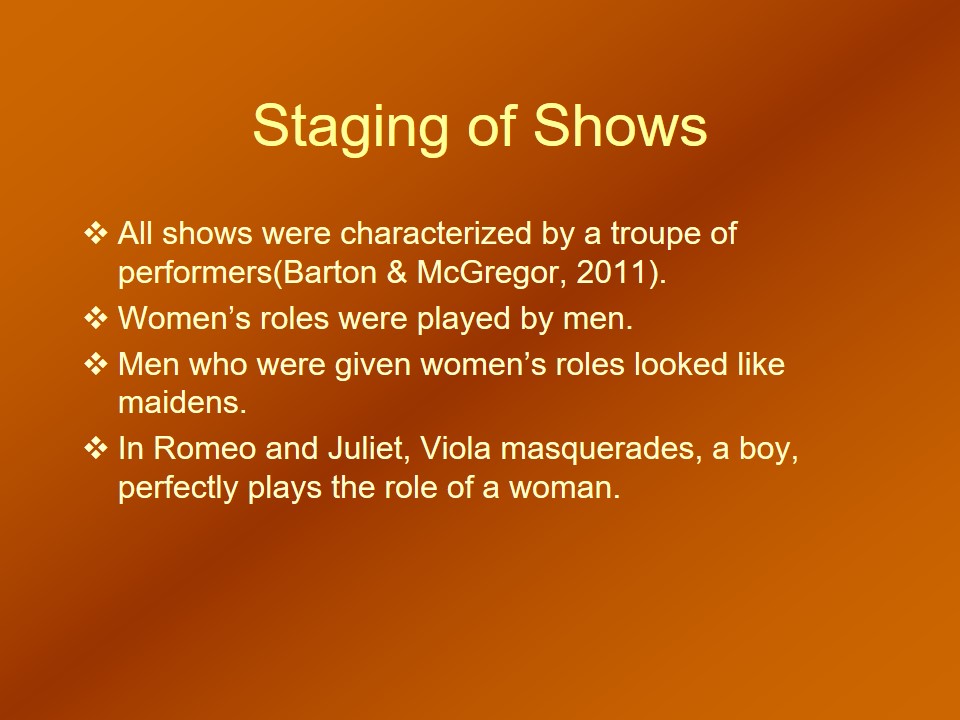
The legacy of Elizabethan Drama
- The Elizabethan drama era facilitated the establishment of the permanent theater.
- Restoration of the monarchy (Barton & McGregor, 2011).
- Shakespeare’s and Johnson’s works found popularity during this period.
- Gave rise to a new generation of performers.
The significance of the Elizabethan error is that it played a major role in redefining drama. The Elizabethan drama era facilitated the establishment of the permanent theater. Also these dramas played a major role in the restoration of the monarchy (Barton & McGregor, 2011). Within this period, a new generation of playwright did not only explore, but also explored the contentious issues effectively during the restoration period. As a result, the works of Johnson and Shakespeare found their popularity. Also, this period gave rise to a new generation of audiences as well as performers.
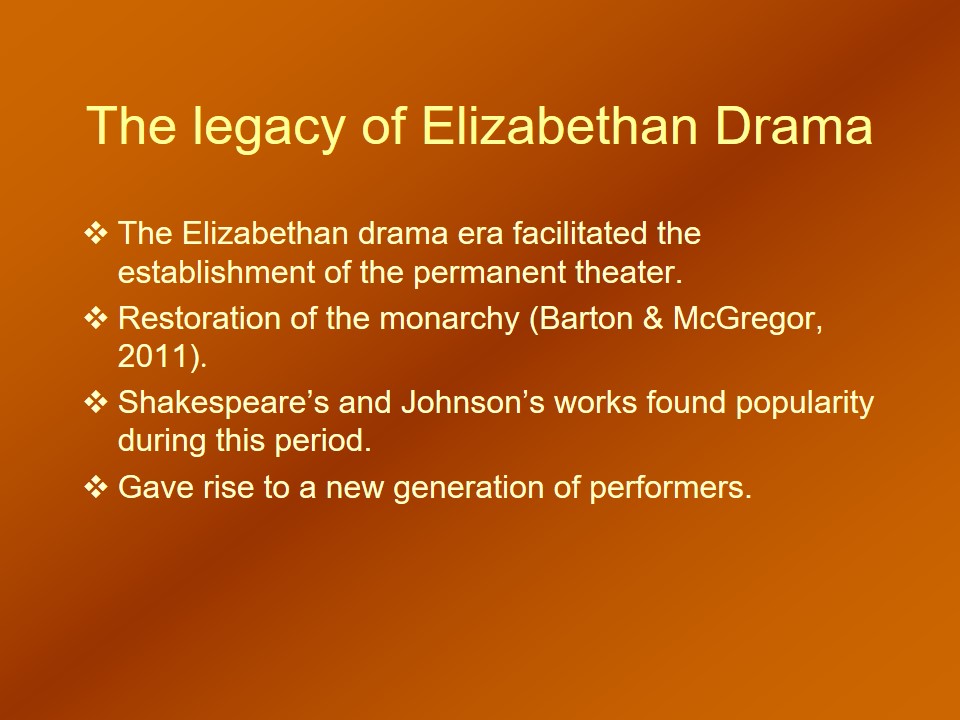
Reference
Barton, R., & McGregor, A. (2012). Theatre in your life (1st ed.). Australia: Wadsworth Cengage Learning.